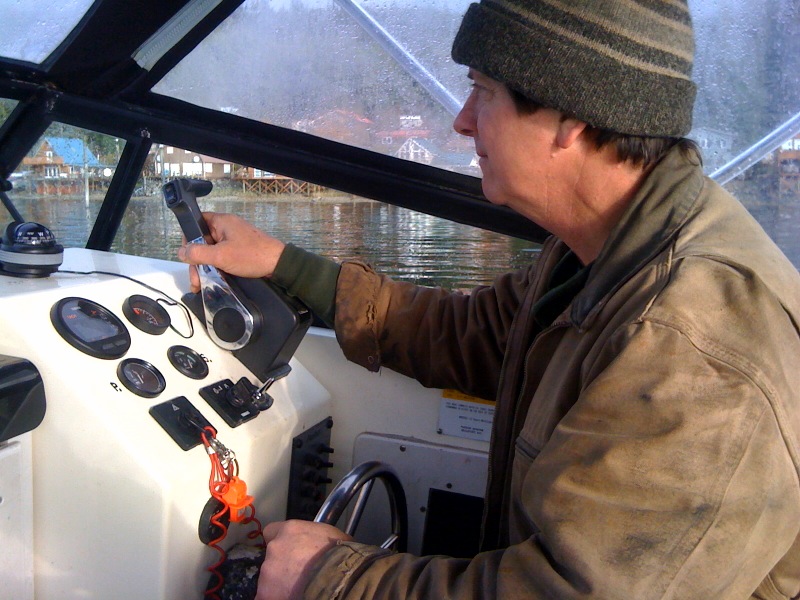
The era of large-scale logging might be gone from northern Southeast Alaska, but across the region, people are turning to smaller timber sales to earn a living. Officials hope the model can support local economies in the region. And for one family in Tenakee Springs, the effort has paid off.
Gordon Chew runs a small logging operation in Corner Bay, just across the inlet from Tenakee Springs. And it keeps him busy. So busy, in fact that he says he doesn’t have time to stop for an interview, but that I can borrow his adult son’s bike and talk to him as we ride down to the harbor. In the interest of my own safety, I wait until we get to his boat before I reach for a microphone.
“We have to do a little bit of everything, between all the boating and barging and lumber milling and logging and construction and restoration around town,” he says.
Chew runs the Tenakee Logging Company, and he’s part of the changing face of the lumber industry. In this part of Southeast Alaska, large-scale logging doesn’t exist anymore. But smaller, selective cuts – like the 100,000 or so board feet each year that Chew takes from the Tongass – are becoming more popular.
Chew’s company logs, but it also builds. He uses the timber taken from Corner Bay on projects in Tenakee Springs. As we leave the harbor, he opens up the throttle and we head to the fuel dock. There’s a 55 gallon drum in the back of the boat.
The fuel will go over to Corner Bay to feed the company’s truck. But not far from where we’re tied up is the Snyder Mercantile – a general store dating back to 1899. Chew and his team are working to restore the old building, along with its adjacent property, using wood they’ve harvested and milled. Chew says that part of the business is essential.
“The foundation under that warehouse are all hemlock pilings,” he says. “We drag a lot of them over here as pilings. Also, the underpart of the store is all repaired with cedar pilings. I’m not sure if we could manage it on our timber sales alone. The fact we get to work with the timber as builders is what makes it lucrative for us. It’s not selling the timber.”
Zia Brucaya, of the Sitka Conservation Society, says Chew’s operation “is definitely unique in our ranger district,” but not to the region.
“Throughout Southeast Alaska there are lots of small mills that are operating to different degrees,” she said. “Some of them are doing construction as well as milling, like Gordon is. Some of them are just doing milling, putting together cabin kits and things. They’re all working at that smaller scale of a few hundred thousand board feet per year.”
SCS and other environmental groups in Southeast have taken an interest in operations like Chew’s because they say they’re smart, sustainable ways to use the Tongass. It was never logging outright that was the problem, she says. It was the scale of what happened in years past.
“We’re now working at a scale that is appropriate for the community, and it’s needed in the community,” she said.
Brucaya says it’s also an opportunity to build up the local economy for the benefit of local residents – a way to keep people living in Southeast, especially in small, remote communities, where the loss of even a family or two can be felt throughout town.
And few are more aware of that than Chris Budke, a forestry technician in the U.S. Forest Service’s Hoonah office.
“It seems like every time I turn around I read something in the paper or I see a reason or I look at people and I see lots of reasons for people to be leaving Southeast Alaska,” he said.
He lists off reasons: it’s a harsh environment, goods and services are expensive, and more. But he says offering opportunities to run small businesses using Tongass resources might help keep people around.
“If we can work with local people that are using local products and meet the objective of everybody – which is really difficult, by the way – and provide a product for those people they can turn around and make a living off of, that, to me, gives you reasons to be here,” Budke said.
And giving people reasons to be here can have big implications for Southeast, which is hemorrhaging population.
“This is incredibly important for people to be working. It’s incredibly important for us to be using our natural resources. It’s incredibly important for people to understand that we can use it responsibly. So we can meet the objectives of a lot of things here and give people a reason to stay in Southeast.”
Gordon Chew and his family are examples of that. They saw Alaska during a trip in 1995, and loved it so much that they went back south and made plans to move up. They returned in 1999 and have been here since. Back in Tenakee Springs, Chew’s 55 gallon drum is nearly full of No. 2 diesel.
As the nozzle is hoisted back onto the fuel dock, Chew says there’s a future in the kind of small-scale logging he does, not only for places like Tenakee Springs, but for the entire region.
Ed Ronco is a reporter at KCAW in Sitka.




